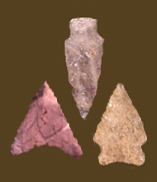
|
BREWERTON SIDE NOTCHED Defining Attributes Chronology Most authorities feel the four point types of the Brewerton Complex were contemporary, although Ritchie (1971) suggests the Side Notched was the oldest. Custer (1996b) places the start of the Brewerton Complex around 4300 BC (calendar) and continuing to perhaps 1600 BC. Justice (1987) suggests a range of 4930 to 3673 BP (approximately 3700-2050 BC calendar), while Funk (1993) suggests 5150 to 4450 BP (approximately 3950-3100 BC calendar) for the Brewerton Complex in the Upper Susquehanna Valley. Description Haft Element: The stem is side notched, occasionally with dual notches. The notches are medium-sized, well-formed, and can be ground. The base is expanded, which sometimes gives it an eared appearance. The base is usually straight or slightly convex, but can be concave, and is often ground. However, only two of the ten Brewerton Side Notched points from the Higgins site in Anne Arundel County exhibited basal grinding (Ebright 1992). Size: Length ranges from 21 to 98 mm, with most between 32 and 57 mm. Width ranges from 16 to 33 mm. Thickness ranges from 5.5 to 13 mm, with most between 8 and 9.5 mm. Technique of manufacture: Made by percussion flaking, with pressure flaked retouching common. Material: In a sample of 91 Brewerton Side Notched points from the lower Patuxent drainage, Steponaitis (1980) reported that 42% were quartz, followed by quartzite (22%), chert (20%), and rhyolite (16%). In the area surrounding Zekiah Swamp on the lower Potomac, Wanser (1982) found that 66% of 184 Brewerton Side Notched points were quartz, with 23% quartzite, 10% rhyolite, and 1% other materials. All 10 Brewerton Side Notched points found at the Higgins site in Anne Arundel County were quartz (Ebright 1992). Stewart (1980) reported that 81% of 21 Brewerton Side Notched-like points in the Hagerstown Valley were rhyolite, with the remainder chert or jasper. Discussion Justice (1987) considers the Brewerton Side Notched to be a re-sharpening variant of the Brewerton Corner Notched, while LeeDecker and Koldehoff (1991) note that Brewertons can resemble re-sharpened Otter Creek points. Ritchie (1971) suggests the Brewerton Side Notched is related to the Otter Creek point, and possibly to other, older side notched types from the Southeast. Brewerton Side Notched points were found with Otter Creek points at the Higgins site, where they probably date to the late Middle Archaic period (Ebright 1992; Dent 1995). Defined in Literature References |
![]()
Search by Shape:
(See Projectile Point Typology) |

|
Thank you for visiting our website. If you have any
questions, comments, Copyright © 2002 by |

|

